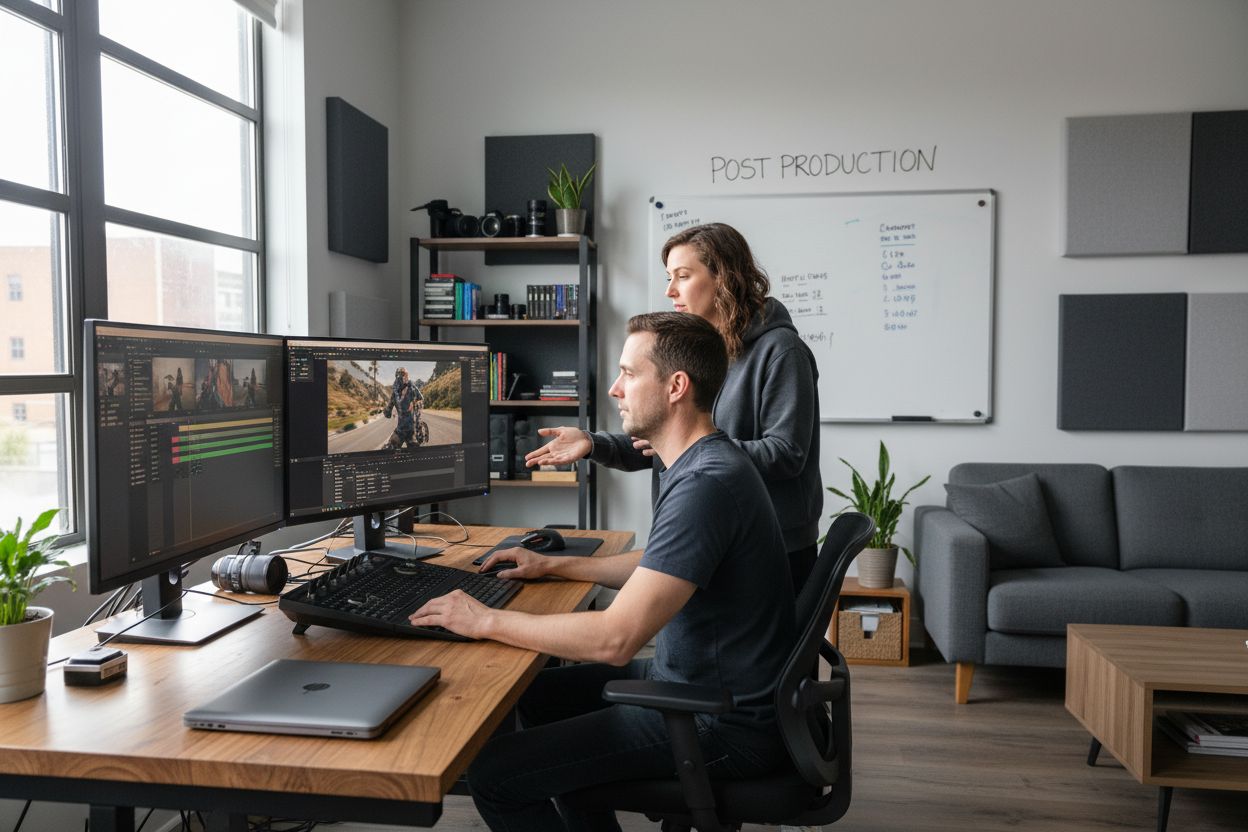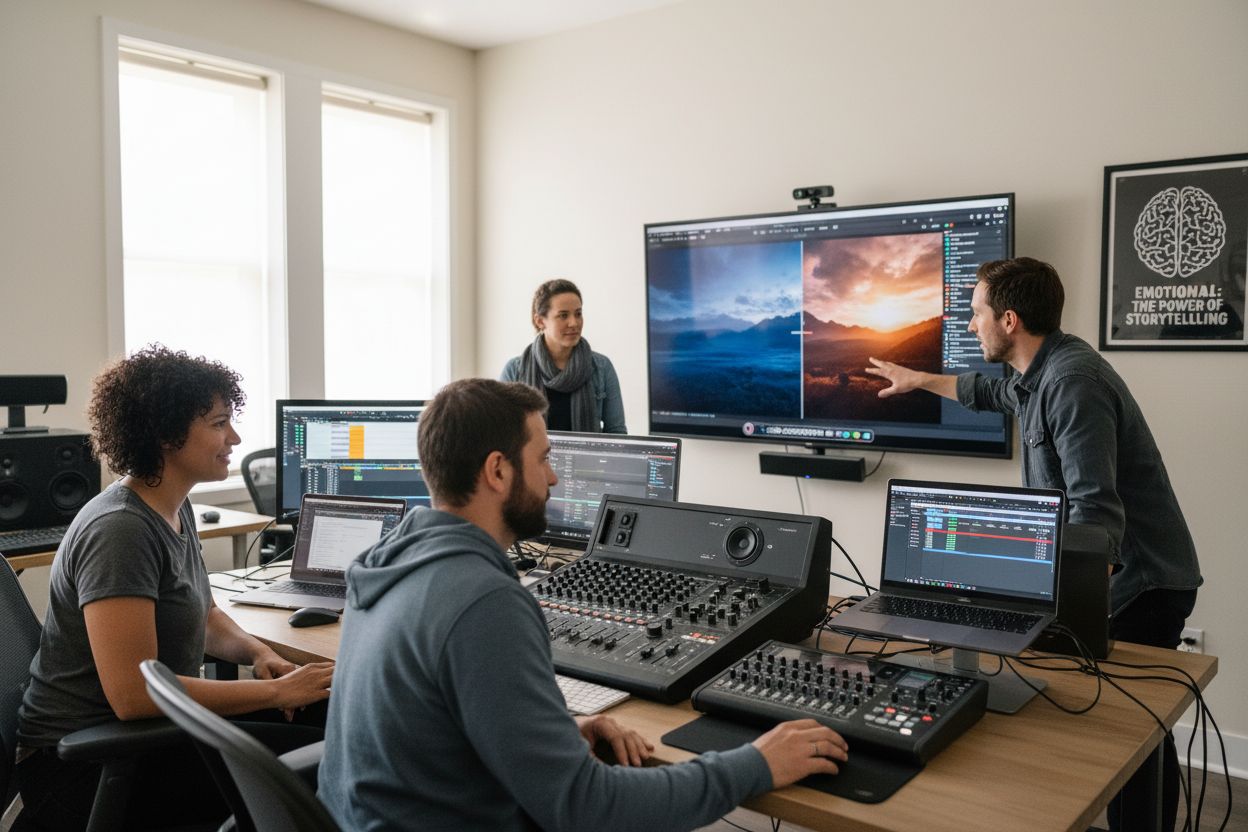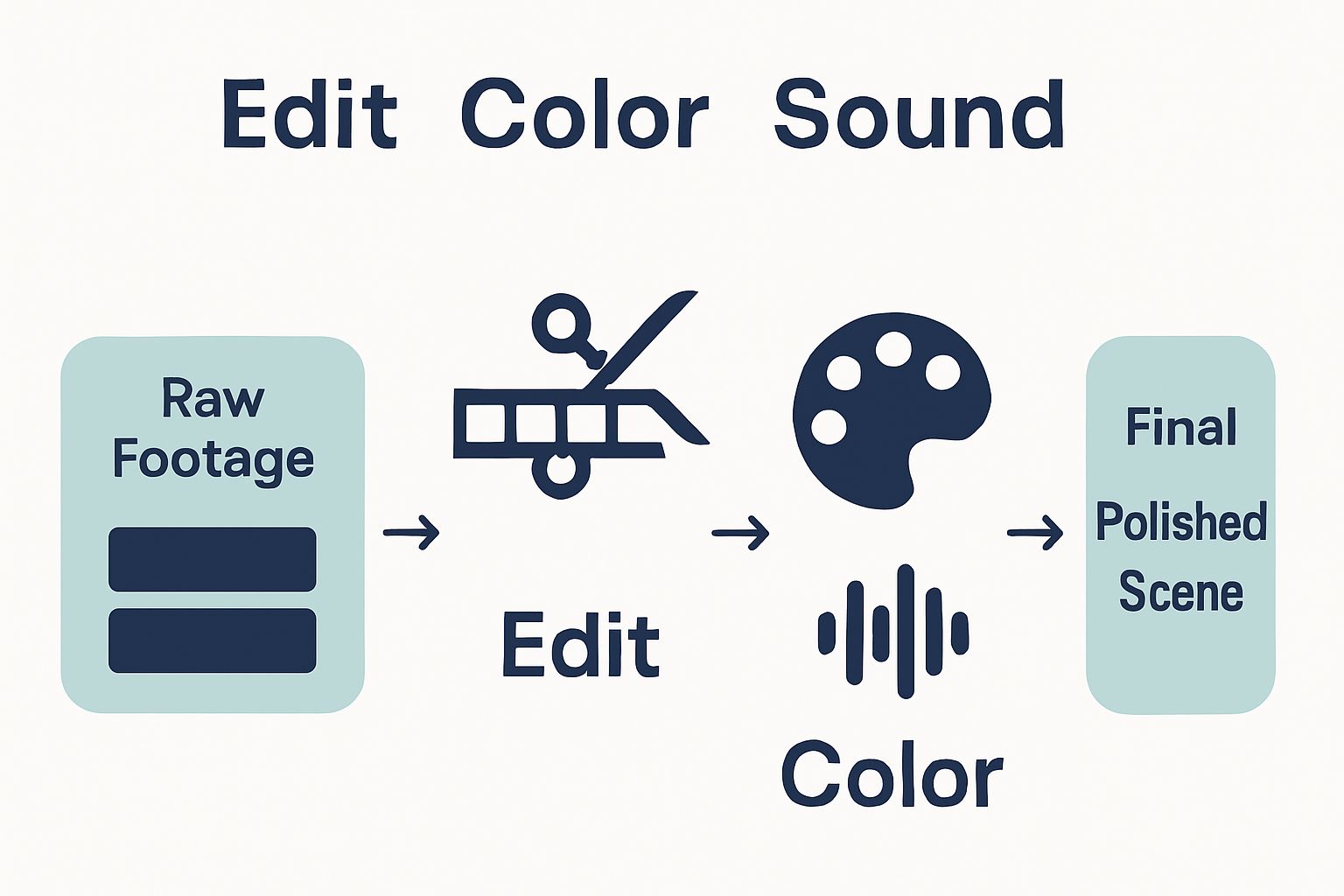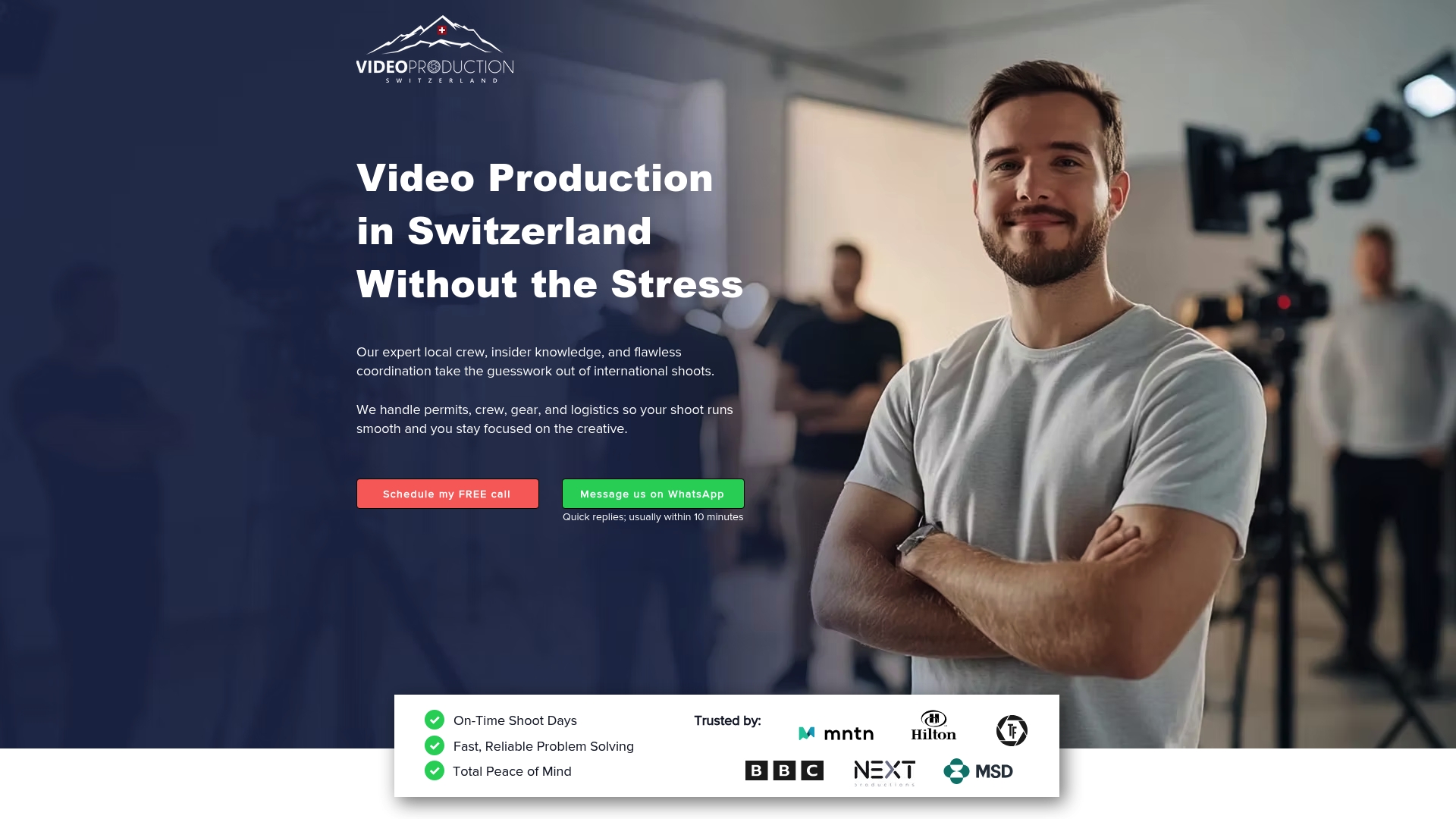Understanding What Happens in Post Production
- info1419758
- Oct 11
- 9 min read

Post production is where raw footage finally starts to look like something worth watching. When you realize that even a basic documentary can involve trimming down over 100 hours of video into a single hour-long story, you get why this stage matters so much. Most people think editing is just about cutting and gluing, but it is actually the moment creative vision meets technical wizardry and turns forgotten files into jaw-dropping stories.
Table of Contents
Quick Summary
Takeaway | Explanation |
Post production transforms raw footage into storytelling. | This phase refines visuals and audio, turning recordings into cohesive narratives that engage viewers. |
Key processes include video editing and sound design. | Essential tasks like editing footage and enhancing audio quality play vital roles in creating polished media. |
Technology enhances creative possibilities in post production. | Advanced software and hardware allow for precise manipulation of visual and audio elements, streamlining workflows. |
Attention to detail impacts audience perception. | Seamless transitions and consistent audio-visual quality significantly influence how viewers connect with the content. |
Post production is crucial across diverse media formats. | Whether for commercials or documentaries, this phase is vital for effective communication of messages and emotions. |
The Basics of Post Production: What Is It?
Post production represents the critical final phase of video creation where raw footage transforms into a polished, professional visual narrative. This comprehensive stage occurs after the initial filming or recording and encompasses a wide range of technical and creative processes that shape the final output.
The table below breaks down the main processes involved in post production and summarizes their specific functions, helping clarify the scope and importance of each step.
Process | Description |
Video Editing and Sequencing | Selecting, arranging, and trimming footage to create a coherent narrative and maintain continuity |
Sound Mixing and Audio Enhancement | Balancing dialogue, sound effects, and music for clarity and emotional impact |
Color Grading and Visual Corrections | Adjusting color balance and correcting visuals for mood and consistency |
Special Effects and Motion Graphics Integration | Adding visual effects and graphics to enhance storytelling |
Title and Graphic Design | Creating titles, captions, and graphic elements for professional polish |
Defining Post Production
At its core, post production is the comprehensive process of editing, refining, and perfecting visual and audio elements after primary production concludes. Professionals use sophisticated software and advanced techniques to manipulate recorded material, creating a cohesive and compelling final product. Our guide on understanding video post production workflow provides deeper insights into these intricate processes.
Key elements of post production typically include:
Video editing and sequencing
Sound mixing and audio enhancement
Color grading and visual corrections
Special effects and motion graphics integration
Title and graphic design
The Creative and Technical Intersection
Post production is where technical precision meets creative vision. Skilled professionals blend advanced technical skills with artistic sensibility to transform raw footage into a narrative that resonates with audiences. According to Adobe’s Professional Video Editing Insights, this phase requires a sophisticated understanding of storytelling principles and technical software capabilities.
Whether creating a commercial, documentary, feature film, or corporate video, post production serves as the critical bridge between captured content and final visual storytelling. It involves meticulous attention to detail, from seamless scene transitions to precise audio synchronization, ensuring that every frame contributes to the overall communicative and emotional impact of the visual project.
The Importance of Post Production in Media Creation
Post production is far more than a technical necessity it is the transformative stage that elevates raw footage into compelling visual storytelling. Professional media creators understand that post production can make or break the final product, determining how effectively a message is communicated and how deeply an audience connects with the content.
Storytelling and Emotional Impact
The true power of post production lies in its ability to shape narrative and emotional resonance. Skilled editors and sound designers can dramatically alter audience perception through strategic editing techniques, color grading, and audio manipulation. By carefully selecting shots, adjusting pacing, and enhancing visual aesthetics, professionals can create powerful emotional experiences that transcend the original recorded material.

Learn more about the stages of video editing for creatives to understand these nuanced techniques.
Key aspects of emotional storytelling in post production include:
Controlling narrative rhythm and tension
Creating visual metaphors through editing
Enhancing mood through color and sound design
Highlighting crucial narrative moments
Removing distracting or unnecessary elements
Technical Quality and Professional Standards
Beyond storytelling, post production ensures professional technical quality that meets industry standards. According to Broadcast Technology Magazine, technical refinement in post production directly impacts audience perception and content credibility.
Professional post production addresses critical technical elements such as color consistency, audio clarity, visual smoothness, and overall production value. These refinements transform amateur footage into polished, broadcast ready content that can compete in competitive media landscapes. Whether for documentaries, commercials, films, or corporate communications, post production represents the critical final stage of professional media creation.
This table highlights how post production impacts both the creative and technical sides of media creation, emphasizing the dual nature of its contributions.
Aspect | Role of Post Production |
Storytelling | Shapes narrative structure and emotional pacing through editing and sound design |
Emotional Impact | Enhances emotional resonance via color, music, and sound effects |
Technical Quality | Ensures color consistency, audio clarity, and visual smoothness |
Professional Standards | Polishes content to meet industry and broadcast requirements |
Key Processes in Post Production and Their Functions
Post production encompasses a complex array of technical and creative processes that transform raw footage into polished visual narratives. Each process serves a specific function in refining and elevating the final media product, working together to create a seamless and compelling visual experience.

Learn more about the comprehensive video production and post production workflow to gain deeper insights into these intricate processes.
Video Editing and Sequence Construction
Video editing represents the foundational process of post production, where raw footage is carefully selected, trimmed, and arranged to create a coherent narrative structure. Editors make critical decisions about shot selection, scene transitions, pacing, and overall storytelling flow. According to Cinema Technology Magazine, professional editing involves more than mechanical cuts it requires an intuitive understanding of narrative rhythm and emotional progression.
Key objectives of video editing include:
Removing unnecessary or redundant footage
Creating logical and engaging narrative flow
Maintaining visual continuity
Establishing emotional resonance
Supporting the intended communication objective
Audio and Visual Enhancement Techniques
Beyond basic editing, post production involves sophisticated audio and visual enhancement techniques. Sound designers meticulously craft audio landscapes by mixing dialogue, adding sound effects, balancing audio levels, and integrating musical scores. Visual effects artists utilize advanced software to color grade footage, correct visual inconsistencies, add digital elements, and create seamless visual transitions.
These technical refinements elevate raw footage from simple recording to professional media content, ensuring that every visual and auditory element contributes to the overall storytelling experience.
Whether for documentaries, commercials, or cinematic productions, these nuanced post production processes transform ordinary recordings into extraordinary visual narratives.
The Role of Technology in Post Production
Technology has revolutionized post production, transforming it from a labor intensive manual process to a sophisticated digital workflow that enables unprecedented creative possibilities. Modern digital tools have fundamentally reshaped how media professionals approach visual storytelling, offering capabilities that were unimaginable just decades ago. Explore our comprehensive guide to the digital video workflow process to understand these technological advancements.
Advanced Software and Creative Capabilities
Professional post production software now provides intricate tools that allow creators to manipulate visual and audio elements with remarkable precision. Programs like Adobe Premiere Pro, DaVinci Resolve, and Avid Media Composer offer complex features that go far beyond basic editing. According to TechMedia Research, these platforms enable professionals to perform tasks that previously required extensive manual intervention or specialized equipment.
Key technological capabilities in modern post production include:
Real time color grading and correction
Advanced visual effects rendering
Multicamera editing synchronization
Automated audio noise reduction
High resolution image stabilization
Hardware and Computational Performance
Behind every sophisticated software lies powerful computational hardware that makes complex post production tasks possible. High performance workstations with multi core processors, extensive RAM, and dedicated graphics cards enable media professionals to handle massive video files, perform real time rendering, and execute complex editing tasks with unprecedented speed and efficiency.
These technological advancements have democratized professional media production, allowing smaller teams and independent creators to achieve results that once required extensive resources and specialized studios. From independent documentaries to high budget film productions, technology continues to expand the creative horizons of post production, making sophisticated visual storytelling more accessible than ever before.
Real-World Impact: Case Studies in Post Production
Post production is not merely a technical process but a transformative art form that can dramatically reshape visual storytelling across multiple media domains. Different industries leverage post production techniques to achieve unique communication objectives, turning raw footage into powerful narratives that resonate with audiences. Discover more about video production and post production essentials to understand these nuanced applications.
Documentary and Journalistic Storytelling
In documentary filmmaking, post production becomes a critical tool for constructing narrative arcs and emotional journeys. Editors and sound designers carefully select and arrange footage to create compelling stories that reveal deeper truths. According to National Documentary Magazine, professional documentarians often shoot hundreds of hours of material, with post production reducing this to a concentrated narrative that maintains authenticity while creating powerful viewer engagement.
Key post production strategies in documentary filmmaking include:
Chronological reconstruction of events
Emotional pacing through strategic editing
Integration of archival and contemporary footage
Subtle sound design to enhance narrative tension
Visual metaphor creation through editing techniques
Commercial and Advertising Transformations
In the advertising world, post production represents the difference between generic content and memorable brand experiences. Marketing professionals utilize sophisticated editing, color grading, and visual effects to create narratives that capture audience attention within seconds. Commercials often require complex visual manipulations that transform ordinary product demonstrations into compelling storytelling experiences.
These case studies demonstrate how post production transcends technical processes, becoming a powerful storytelling mechanism that can educate, inspire, and emotionally connect audiences across various media platforms. From documentaries revealing societal complexities to advertisements creating memorable brand moments, post production continues to reshape how we perceive and interact with visual media.
Ready to Turn Raw Footage Into a Flawless Story?
Every filmmaker knows the frustration of seeing their vision get lost in post production. Challenges like technical inconsistencies, unclear narratives, or the pressure of meeting international standards can quickly overwhelm even experienced professionals. This article has highlighted how post production shapes your message, manages color grading, sound, and editing, and determines the success of your project. Imagine handing those critical steps to a team that not only understands the art of post production but also eliminates the stress of Swiss permits, equipment sourcing, and crew management.

Let your story reach its full potential. Discover how Video Production Switzerland helps international filmmakers go from raw footage to professional results with complete local support. Whether you are seeking insights on video post production workflow or a trusted team for seamless logistics and execution, we deliver every detail with precision. Take the next step today and ensure your production gets the expertise it deserves—explore our comprehensive services and book your free consultation now.
Frequently Asked Questions
What are the main processes involved in post production?
Post production includes several key processes such as video editing, sound mixing, color grading, and adding special effects. Understanding these components is essential to transform raw footage into a polished final product. Familiarize yourself with each process to enhance the quality of your media.
How can video editing improve the storytelling in my project?
Video editing enhances storytelling by selecting the best footage, controlling pacing, and ensuring visual continuity. Good editing can create emotional engagement, making your narrative more impactful. Focus on removing unnecessary content to create a more cohesive story.
What role does audio enhancement play in post production?
Audio enhancement is crucial for clarity and emotional impact in your project; it involves mixing dialogue, adding sound effects, and balancing audio levels. To improve your audio quality, consider investing time in sound design techniques that elevate your overall narrative. Aim for a clear, immersive audio experience that complements your visuals.
How long does the post production process typically take?
The duration of post production can vary greatly depending on the project’s complexity, but it often spans from a few days to several weeks. To streamline this phase, create a clear timeline with milestones for each post production stage. Set an initial goal of completing basic editing within 30 days to keep your project on track.
What is color grading, and why is it important in post production?
Color grading is the process of adjusting the color and tone of your footage to enhance visual appeal and mood. This step is vital for maintaining color consistency and creating the desired atmosphere in your video. Start by experimenting with a color correction workflow to refine the look of your footage effectively.
How can I ensure the technical quality of my post production work?
Ensuring technical quality involves addressing elements like audio clarity, visual smoothness, and overall production value during post production. Regularly check your footage for consistency and clarity to meet industry standards. Strive for high-quality edits by reviewing your work against best practices in video production.
Recommended

Comments